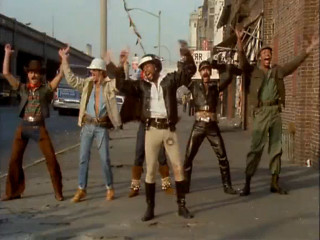
The above image depicts New York City’s Gay Pride Parade (Wolak).
By the late 1970s, disco continued to grow in popularity with groups such as the Bee Gees paving the way for mainstream audiences to enjoy the craze. But it was the Village People’s formation that filled a needed musical void at the time. Despite disco originating from the gay New York underground, there was a major lack in groups that could both represent disco’s gay roots and appeal to mainstream American listeners. Producer and chief songwriter Jacques Morali described this void as a “culturally unsatisfied, commercially unexploited niche in popular music” and pointed out that “the Village People’s mix of iconic American masculinity, gay innuendo, and maddeningly catchy disco hooks was the perfect fit” (Midgley 107). Songs such as “Y.M.C.A.” pushed against the mainstream forces of the Bee Gees and the film Saturday Night Fever, which “deleted any trace of the downtown night network” and, instead, appealed mostly to white suburbia (Lawrence 307). The underlying lyrical nod to the popular meetup spot, as discussed earlier, appealed to gay communities while the song’s “undeniable, jingle-like hook” fed into its mainstream appeal and rocketed the song up the Billboard Hot 100 chart (Pearlman). First debuting on the Hot 100 chart on November 11, 1978, the song eventually peaked at No. 2 just thirteen weeks later. With mainstream success, the Village People inevitably furthered the Gay Rights Movement by becoming “models of successful, positive, happy gay men that countered the spectre of sin, criminality, and illness that had accumulated around homosexuality over centuries,” which masterfully balanced their mainstream and gay appeal (Midgley 105). Furthermore, their positive representation of the disco community is embodied in the well-respected professions, except the leather man and Native American caricature, that the group dressed-up as. Even though disco as a musical movement inevitably lost steam, the Village People’s “Y.M.C.A.” remains a mainstay at baseball games, parties, clubs, and radios. This effectually immortalized the group’s mainstream success as well as their positive representation of the gay disco community.

In the above image, the Village People perform their famous Y.M.C.A. dance by shaping their arms into a Y-formation (Corcione).